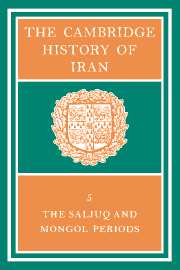Book contents
- Frontmatter
- 1 THE POLITICAL AND DYNASTIC HISTORY OF THE IRANIAN WORLD (A.D. 1000–1217)
- 2 THE INTERNAL STRUCTURE OF THE SALJUQ EMPIRE
- 3 RELIGION IN THE SALJUQ PERIOD
- 4 DYNASTIC AND POLITICAL HISTORY OF THE IL-KHĀNS
- 5 THE ISMĀ‘ĪLĪ STATE
- 6 THE SOCIO-ECONOMIC CONDITION OF IRAN UNDER THE ĪL-KHĀNS
- 7 RELIGION UNDER THE MONGOLS
- 8 POETS AND PROSE WRITERS OF THE LATE SALJUQ AND MONGOL PERIODS
- 9 THE VISUAL ARTS, 1050–1350
- 10 THE EXACT SCIENCES IN IRAN UNDER THE SALJUQS AND MONGOLS
- Bibliography
- Index
- Plate section
- References
10 - THE EXACT SCIENCES IN IRAN UNDER THE SALJUQS AND MONGOLS
Published online by Cambridge University Press: 28 March 2008
- Frontmatter
- 1 THE POLITICAL AND DYNASTIC HISTORY OF THE IRANIAN WORLD (A.D. 1000–1217)
- 2 THE INTERNAL STRUCTURE OF THE SALJUQ EMPIRE
- 3 RELIGION IN THE SALJUQ PERIOD
- 4 DYNASTIC AND POLITICAL HISTORY OF THE IL-KHĀNS
- 5 THE ISMĀ‘ĪLĪ STATE
- 6 THE SOCIO-ECONOMIC CONDITION OF IRAN UNDER THE ĪL-KHĀNS
- 7 RELIGION UNDER THE MONGOLS
- 8 POETS AND PROSE WRITERS OF THE LATE SALJUQ AND MONGOL PERIODS
- 9 THE VISUAL ARTS, 1050–1350
- 10 THE EXACT SCIENCES IN IRAN UNDER THE SALJUQS AND MONGOLS
- Bibliography
- Index
- Plate section
- References
Summary
PRE - SALJUQSCIENCES
In commencing a description of the mathematical sciences as practised and developed in Iran during the three and a half centuries beginning with, say, 430/1038, it is useful to review accomplishments in the field up to that time. Having assessed the accumulated scientific capital available, as it were, to the mathematicians and astronomers of the period, consideration can then be given to the manner in which they maintained, enhanced, or neglected the fund of knowledge they inherited.
One essential tool for any serious work, a place-value number system, had been at hand for three millennia. The calculus of sexagesimals, which had been developed in Mesopotamia, came to the Islamic world via the Greeks. It continued to be fully exploited for numerical operations throughout medieval times. The decimal system (but without fractions) was introduced into the Middle East from India during the ‘Abbāsid period. It did not become a serious competitor to sexagesimals until much later, nor was there any reason why it should.
Following the Pythagorean discovery of irrational ratios, the Greeks constructed a rigorous theory of the continuum, the process entailing a clear formulation of the notion of a limit. This body of doctrine likewise was taken over by the Muslims and subjected to repeated critical examination by numerous scholars. The same goes for geometric algebra, including a systematic treatment of the quadratic equation and a few cubics, euclidean plane and solid geometry, Apollonius' work on conic sections, “analemma” methods (i.e. descriptive geometry), various categories of analogue computers, e.g. the astrolabe based on stereographic mapping, planetary equatoria, and so on.
- Type
- Chapter
- Information
- The Cambridge History of Iran , pp. 659 - 680Publisher: Cambridge University PressPrint publication year: 1968
References
- 8
- Cited by



